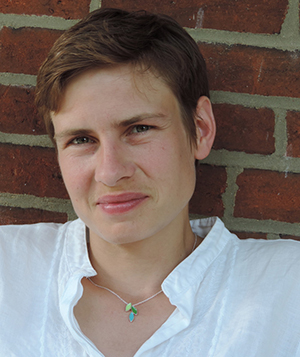
Anika Walke
There are no certain guides for rebuilding a society in the aftermath of systematic violence and genocide against one of its populations and its culture. Nevertheless, some societies address their histories more effectively than others, as found by Anika Walke, a German expat working as an assistant professor of History at Washington University in St. Louis.
“Born and raised in Germany, I learned about and was confronted with the history and memory of the Nazi regime and the Holocaust from an early age,” Walke said. She noticed that minimal attention given to the rich Jewish history of her hometown, Karl-Marx-Stadt. “Of course, Karl-Marx-Stadt was not unique and merely one example of the omissions created by the politics of memory in East Germany.”
In a presentation she will give at USC Shoah Foundation’s 2017 International Conference “Digital Approaches to Genocide Studies,” co-sponsored by the USC Mellon Digital Humanities Program, Walke will describe her research on the long aftermath of Nazi genocide in Belarus, where more than 80 percent of the Jewish population was killed during German occupation.
In order to force stories into open discussion and get around communities’ neglect in finding appropriate forms to commemorate the losses of major parts of their populations, Walke has made a visualization of two small Belarusian towns, Beshenkovichi and Bykhov, which have remained largely oblivious to the issues of local participation and erasure of their Jewish history.
“I use visualization techniques such as mapping to show the contrast between a prewar Jewish presence that was thoroughly integrated in the local communities of the former Pale of Jewish Settlement, and postwar modes of memory and commemoration that push the memory of Jewish lives to the geographical margins of towns and villages,” Walke said.
Her argument, which she will present at the two-day conference at the University of Southern California in Los Angeles, hinges on the idea that this marginalization “reflects the obstacles and unwillingness of Belarusian society to confront issues such as the participation of locals in the round-up and even killing of their Jewish neighbors.”
Walke’s talk will fit right in at the conference, where she’ll sit on a panel discussing the digital visualization of Holocaust spaces alongside other scholars excited to discuss the relationship between digital methodologies, practices, ethics and the nature of contemporary Holocaust and Genocide Studies.
In its initial call for papers, USC Shoah Foundation asked academics to investigate the ways in which digital tools and methods, new media and information technologies can help us to challenge conventional wisdom regarding the Holocaust and Genocide Studies by raising new questions, improving our understandings, deepening our analyses, widening our fields of view and pioneering new approaches.
The conference will feature over a dozen scholars presenting on a variety of subjects, from an analysis of the netnography of digital autobiographical documentary to the capacities of geographic information systems for analyzing Holocaust spaces to the usefulness of augmented reality technologies in sharing the memories of the places of genocides.
“I have recently begun to explore geovisualization methods to analyze my research material and am interested in sharing my preliminary results with other scholars who are utilizing new methods to study the history and memory of genocide,” Walke said.
Much of her research draws heavily on the use of testimonies, oral history and personal accounts of the Holocaust, putting Walke in direct conversation with USC Shoah Foundation’s Visual History Archive, a collection of over 54,000 digitized and fully searchable video testimonies from survivors and other eyewitness of the holocaust, the Rwandan, Guatemalan and Armenian genocides and the Nanjing Massacre in China.
“I have worked extensively with testimonies collected by the Visual History Archive in preparation of my first book,” Walke said. “I was also lucky to participate in a workshop for Ph.D. candidates, jointly organized by USC Shoah Foundation and Yad Vashem in Fall 2011.”
Her book, Pioneers and Partisans: An Oral History of Nazi Genocide in Belorussia, intertwines oral histories, video testimonies and memoirs to show how the first generation of Soviet Jews experienced the Nazi genocide and how they remember it following the dissolution of the Soviet Union in 1991.
For Walke, the Archive and the Institute exist as a platform for marginalized voices that she looks forward to continuing to study.
“Interviewing survivors and witnesses gives us insights into how people interpreted and perceived what happened around them,” Walke said. “In many cases, testimonies illuminate experiences that are not only not available because no archive was created at the time…but also because civilians – especially women, children or the elderly – are often not seen as valuable historical subjects. As a result, the diversity of experience is not taken into account and particular risks or chances that people face because of their identity cannot be uncovered.”